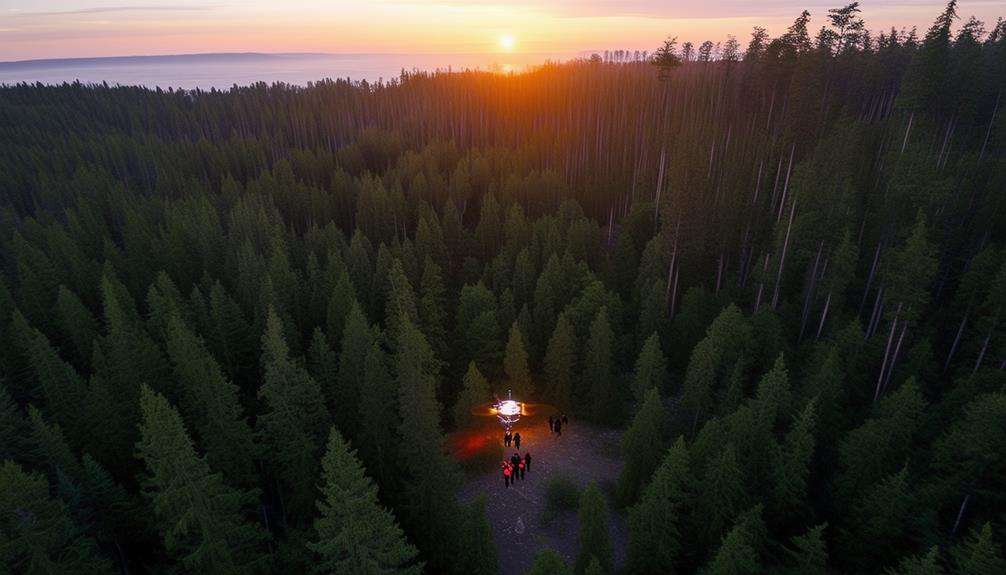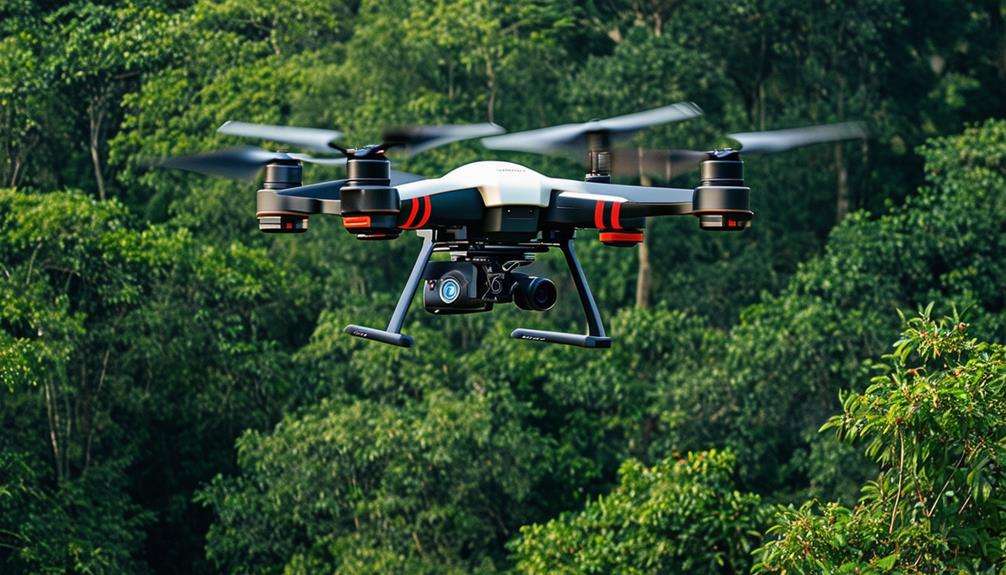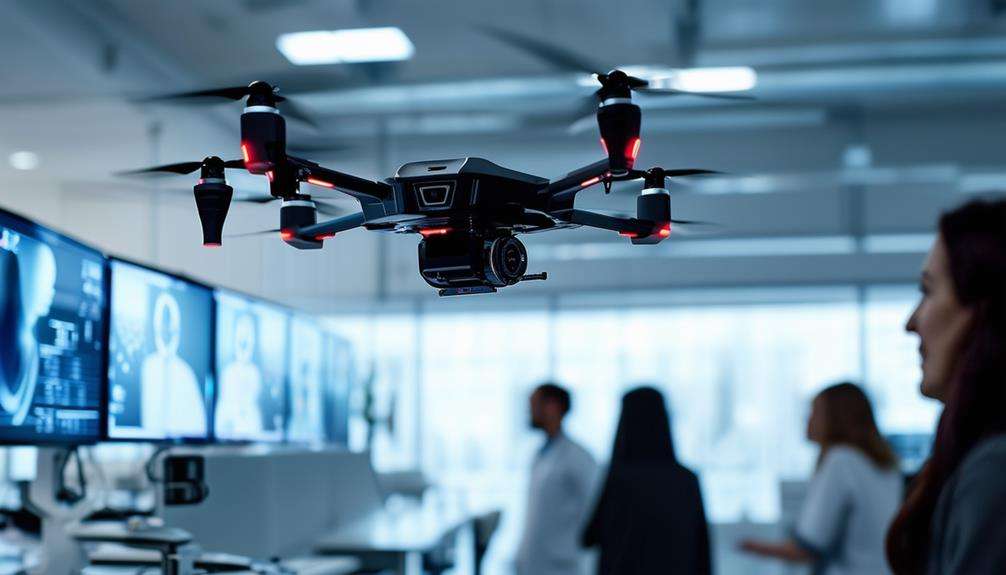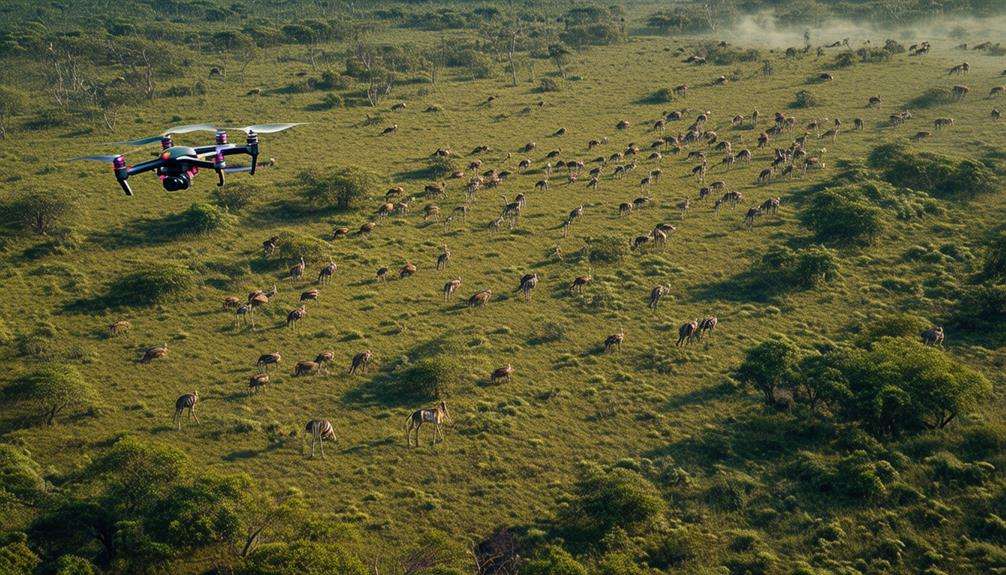The Use of Drones in Avalanche Rescue Operations
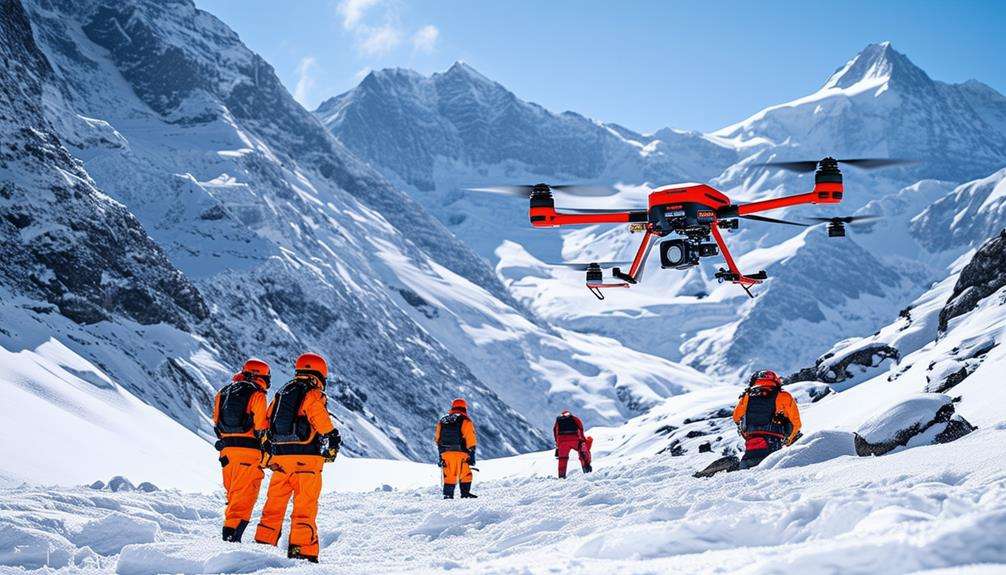
Imagine you're part of a mountain rescue team, faced with the challenging task of locating avalanche victims buried under tons of snow. Drones have revolutionized this demanding scenario by providing rapid, real-time data through thermal imaging and GPS technology.
These devices can scan vast, treacherous terrains in a fraction of the time it would take ground teams, significantly enhancing the chances of a successful rescue. But how exactly do these advanced tools integrate into traditional rescue methods, and what does the future hold for drone-assisted operations?
Evolution of Avalanche Rescue
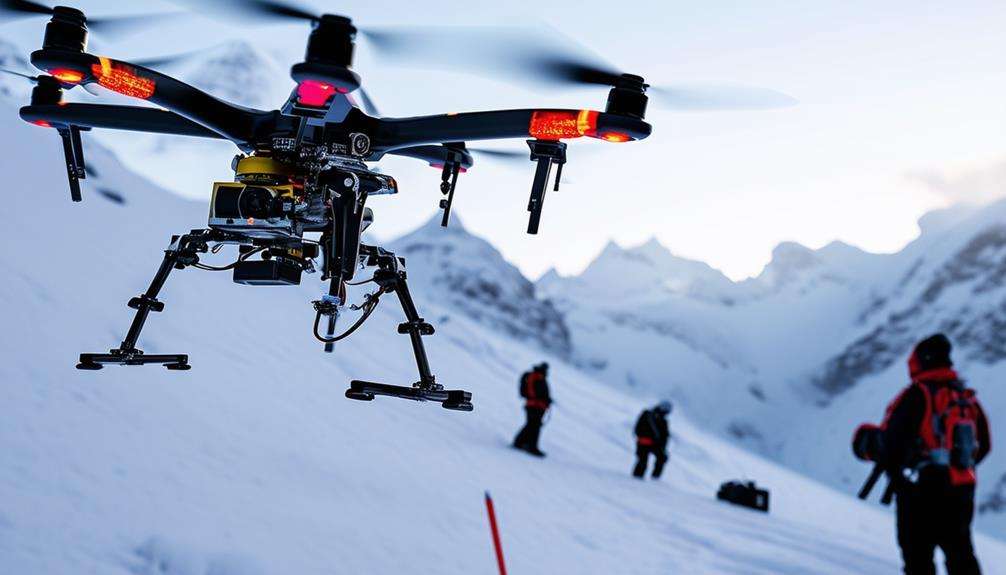
How have avalanche rescue operations transformed with the advent of drone technology?
The integration of drones into search and rescue operations has revolutionized the field. Equipped with advanced thermal cameras, these drones can quickly and efficiently locate avalanche victims, even in the most remote and hazardous terrains.
Before drones, rescuers often faced significant delays and risks when maneuvering through unstable snowfields. Now, drones provide real-time aerial views, allowing teams to assess the situation from a safe distance. This crucial information helps them plan their operations more effectively, ensuring that every move is calculated and precise.
The thermal cameras mounted on these drones have become game-changers. They can detect heat signatures from buried victims, even under several feet of snow. This technology drastically reduces the time it takes to locate someone, making the difference between life and death in many cases.
With drones, response times have markedly decreased, and the success rates of finding and rescuing victims have improved significantly. The enhanced safety for both rescuers and victims ensures that rescue operations aren't only faster but also more effective and secure.
How Drones Aid Rescues
Drones equipped with thermal cameras revolutionize avalanche rescue efforts by quickly pinpointing victims through their body heat signatures. In the critical moments following an avalanche, these drones save valuable time by locating individuals buried under snow. Their aerial views allow rescuers to assess terrain conditions and plan the safest, most effective routes to reach those in need.
In remote and hazardous areas, drones can deliver essential supplies such as food, water, and medical kits to stranded victims, a crucial capability when ground teams face delays or challenging conditions. Real-time video feeds from drones provide situational awareness to ground teams, ensuring better coordination and more effective rescue operations.
Using drones in avalanche rescues not only accelerates response times but also significantly improves victims' chances of survival. Acting as eyes in the sky, drones help rescue teams make informed decisions, avoid hazards, and focus efforts where they're needed most.
Overview of BARDS System
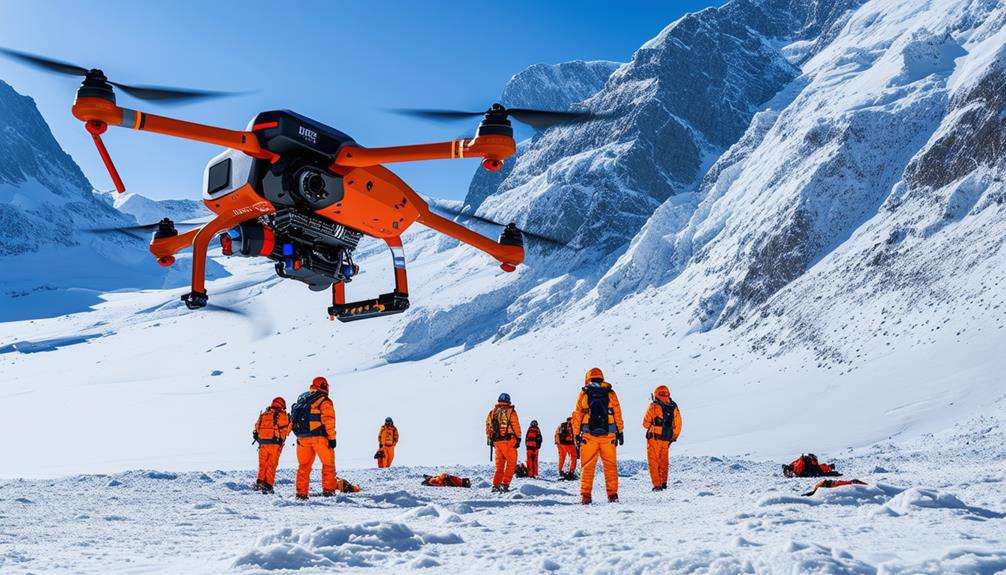
The BARDS system enhances avalanche response with its advanced drone detection capabilities, ensuring swift and precise victim location. Real-time data transmission enables rescue teams to act promptly and effectively.
Drone Detection Capabilities
The BARDS system leverages cutting-edge technology to significantly enhance the speed and precision of avalanche victim detection. By integrating drone technology with avalanche receivers and transceivers, BARDS efficiently locates and rescues victims in backcountry environments. Each team member is equipped with essential gear, including avalanche transceivers, probes, shovels, and a specialized drone.
At the heart of the BARDS system is its drone, outfitted with a computer and software-defined radio. This configuration enables the drone to perform accurate searches, identifying victim locations swiftly. The system executes multiple search types—signal, coarse, fine, and pinpoint—to ensure victims are found within five minutes.
Smith's design for the BARDS system prioritizes speed and accuracy, aiming to surpass traditional search methods. This innovative approach dramatically improves victim recovery, making it an invaluable asset in avalanche rescue operations.
The drone's capability to cover extensive areas rapidly and relay precise location data to ground rescuers is transformative. Thus, the BARDS system signifies a major advancement in the efficiency and effectiveness of avalanche rescue missions.
Real-Time Data Transmission
By harnessing real-time data transmission, the BARDS system ensures that rescuers receive immediate and precise victim location updates, significantly enhancing the effectiveness of avalanche rescue operations. The system integrates drones, avalanche receivers, and signals to create an uninterrupted flow of information, a crucial advantage for rescue teams. Each team member is equipped with essential tools such as avalanche transceivers, probes, shovels, and a drone. This coordinated effort ensures no time is wasted in the critical initial minutes following an avalanche.
The drone, a vital component of the BARDS system, is outfitted with a computer and software-defined radio. This configuration allows for precise search and rescue operations through various search phases—signal, coarse, fine, and pinpoint. These phases enable rapid victim geo-location, often within five minutes, a significant improvement over traditional methods. The immediacy facilitated by real-time data transmission can be the difference between life and death.
Here's an emotional comparison of what BARDS achieves:
| Emotion | Traditional Methods | BARDS System |
|---|---|---|
| Desperation | Endless searching | Immediate location updates |
| Hope | Gradual fading | Quick and accurate rescue |
| Relief | Rarely felt | Frequently achieved |
Real-time data transmission is revolutionizing avalanche rescue operations, bringing hope and relief to many.
Enhanced Rescue Efficiency
Leveraging advanced technology, the BARDS system significantly enhances the speed and precision of avalanche rescues. Integrating drones, avalanche receivers, and beacons, BARDS optimizes rescue operations. Each team member carries essential gear and a drone equipped with software-defined radio, ensuring a streamlined and effective search process.
BARDS executes multiple search phases—signal, coarse, fine, and pinpoint—to rapidly locate avalanche victims. This multi-phase strategy allows the system to accurately identify victims' positions in under five minutes. Such swift identification is crucial, as every second is critical in avalanche rescue scenarios.
Traditional search methods often take considerably longer and can be less accurate. BARDS surpasses these methods by reducing victim recovery time, thereby increasing survival chances. The system's precise marking of victims' locations enables rescue teams to reach and recover them quickly, significantly improving the efficiency of rescue operations.
Speed and Efficiency Gains
Drones in avalanche rescue operations offer significant speed and efficiency gains. They can be rapidly deployed, locating victims in under five minutes. Enhanced search accuracy ensures that rescue teams can respond swiftly and precisely.
Rapid Deployment Capabilities
Drones significantly reduce response times in avalanche rescue operations, facilitating quick aerial assessments and faster victim location. Their rapid deployment capabilities revolutionize emergency response situations. When every second counts, drones can be deployed almost immediately, efficiently covering large areas.
Their ability to get airborne quickly enables rescuers to identify avalanche zones and potential victim locations without delay.
Consider a scenario where an avalanche has just occurred. Traditional methods might involve deploying search teams on foot or by helicopter, which consumes valuable time. In contrast, drones can be launched within minutes, providing a comprehensive aerial view of the affected area. This allows search and rescue teams to immediately focus their efforts on the most critical zones.
Enhanced Search Accuracy
By rapidly deploying drones, search and rescue teams can significantly improve their accuracy and efficiency in locating avalanche victims. Drones can identify the exact location of victims in less than five minutes, a level of speed and precision that traditional methods often struggle to achieve. This rapid response is crucial for saving lives.
Here are four ways drones enhance search accuracy and efficiency in avalanche rescue operations:
- Quick Identification: Equipped with thermal imaging technology, drones can swiftly detect heat signatures beneath the snow, significantly enhancing search accuracy and speeding up the rescue process.
- Real-time Data: Live video feeds from drones provide rescuers with up-to-the-minute information, enabling them to make quick and informed decisions about where to concentrate their efforts.
- Precise Marking: Once a victim is identified, drones can mark the exact location, allowing rescuers to proceed directly to the site without wasting valuable time.
- Coverage Efficiency: Drones can quickly cover large and challenging terrains, ensuring that no area is overlooked and maximizing the efficiency of the search operation.
Technological Components
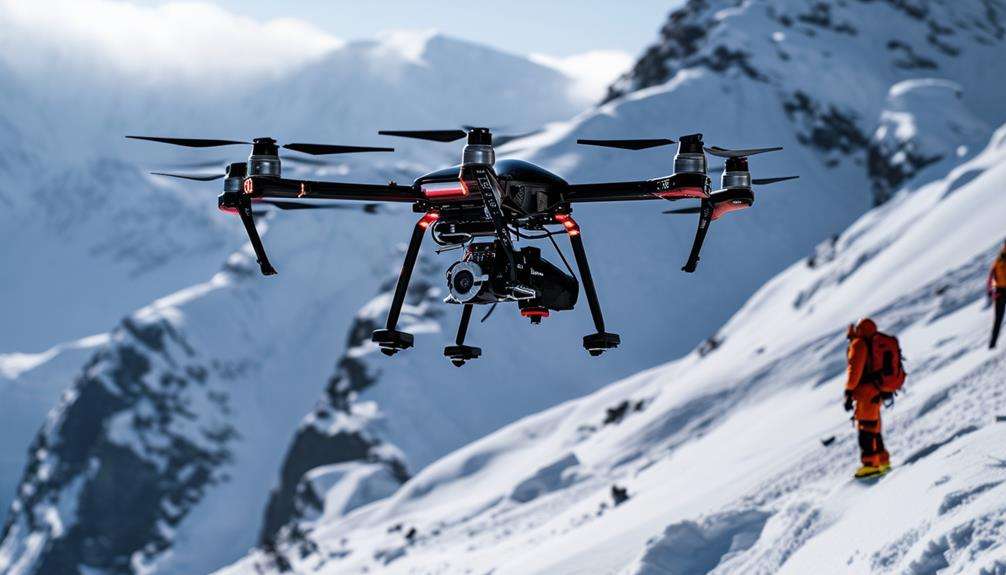
The software-defined radios in avalanche rescue drones are crucial for maintaining seamless communication during search operations. These radios ensure a strong and reliable connection with the drone, even in harsh weather conditions, which is essential for coordinating rescue efforts efficiently and increasing the likelihood of saving lives.
Controlled remotely through advanced systems, these drones offer remarkable precision. They can conduct signal, coarse, fine, and pinpoint searches to locate avalanche victims swiftly. This multi-layered search capability allows for rapid identification of the victim's location, often within minutes. The technological components of these drones, including their radios and sophisticated search algorithms, work together to facilitate this process.
Additionally, these drones are equipped with sensors and cameras that provide real-time data and high-resolution imagery. This information enables quick situational assessment and informed decision-making. The integration of these advanced technological components in avalanche rescue drones significantly enhances the speed and accuracy of rescue operations, providing a critical life-saving advantage.
Case Studies and Success Stories
The Alaska Department of Transportation & Public Facilities has set a new benchmark in avalanche mitigation by successfully integrating drones, enhancing both safety and efficiency in hazardous conditions. By utilizing FAA-approved unmanned aerial systems (UAS) equipped with explosives, they've transformed the way avalanches are managed and controlled.
Key case studies and success stories that highlight the effectiveness of this approach include:
- Enhanced Safety: The use of drones has significantly reduced risks to human lives by enabling remote avalanche triggering. This eliminates the need for rescue teams to physically enter dangerous zones, substantially lowering the chances of injuries and fatalities.
- Increased Operational Efficiency: Drones have optimized operational workflows, resulting in faster response times and reduced traffic disruptions. This efficiency has been crucial for maintaining essential transportation routes during periods of heavy snowfall.
- Cost-Effectiveness: Traditional methods of avalanche mitigation are often expensive and labor-intensive. Drones provide a cost-efficient alternative, allowing for better resource management without sacrificing safety or effectiveness.
- Blueprint for Future Applications: The successful implementation in Alaska serves as a valuable model for other regions and industries. These case studies illustrate the broader potential for drones to enhance safety and efficiency in various applications.
These success stories demonstrate the transformative impact of integrating drones into avalanche mitigation strategies, offering a roadmap for future innovations in the field.
Future of Drone-Assisted Rescues
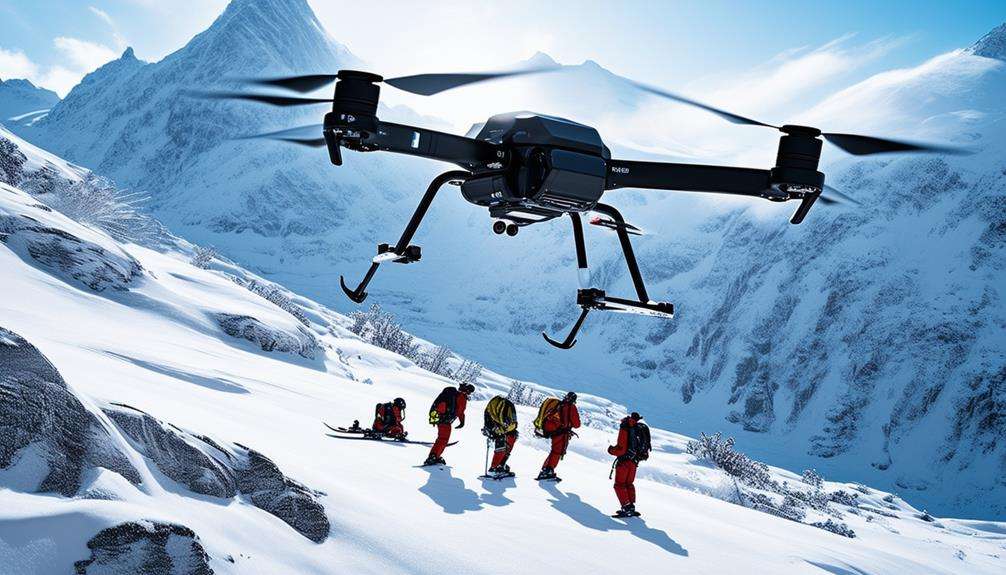
Imagine a future where drones swiftly hover over snow-covered mountains, pinpointing avalanche victims with unparalleled speed and precision. Rescue teams will leverage advanced drone technology to significantly reduce response times, enhancing safety and saving lives.
Drones equipped with thermal imaging and aerial mapping capabilities will make it easier to locate victims buried under snow. They will scan large areas quickly, providing rescuers with accurate data for immediate action. With improved technology, drones will detect victims faster and more accurately, decreasing the time someone spends trapped under snow.
| Drone Capability | Current Benefits | Future Enhancements |
|---|---|---|
| Thermal Imaging | Detects heat signatures | Higher resolution imaging |
| Aerial Mapping | Maps large areas quickly | Real-time 3D mapping |
| Quick Deployment | Fast response times | Automated and pre-programmed missions |
Using drones in avalanche rescue operations is likely to become standard practice. As technology advances, these aerial tools will become more precise and efficient, ensuring that rescue teams can reach victims faster than ever before. The future of avalanche rescue operations looks promising, with drones enhancing both the speed and effectiveness of life-saving efforts.
Conclusion
Drones have revolutionized avalanche rescue operations with their thermal cameras and rapid deployment capabilities, making the search for buried victims faster and more efficient. Utilizing advanced technologies like the BARDS system, drones have significantly increased the chances of survival for many individuals.
As this technology continues to evolve, it promises even greater advancements, ensuring that rescue missions are more effective and timely than ever before.

